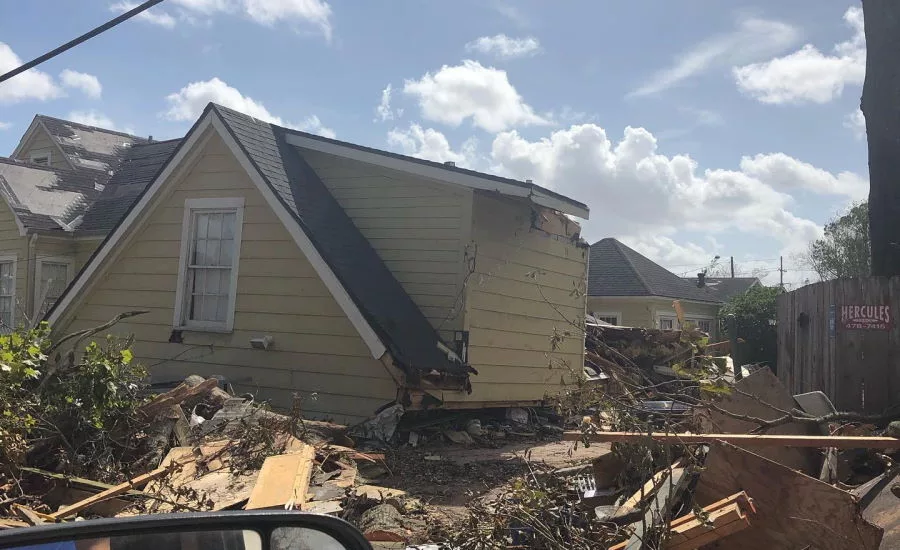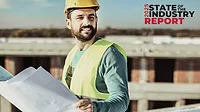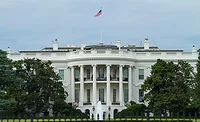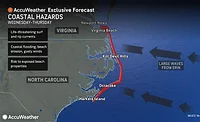Storm-Weary Roofing Contractors Brace for Hurricane Delta
Back-to-Back Hurricanes Emphasize Need for Building Reinforced Roofs

Louisiana is still struggling to recover from Hurricane Laura, and is expected to take another hit from Hurricane Delta on Oct. 9. Photo courtesy of Superb Roofing/Facebook.
Much like the rest of 2020, this year’s storm season is one for the history books, with a seemingly endless barrage of hurricanes devastating the Gulf Coast and causing roofing contractors to struggle with the influx of work.
After enduring back-to-back storms in the forms of Hurricanes Laura and Sally, Hurricane Delta — the 25th named storm in the Atlantic hurricane season — is predicted to make landfall in the U.S. this evening. Models predict it will hit the Louisiana coast as a Category 3 hurricane, bringing with it damaging winds, flooding and storm surges.
Louisiana is still struggling with recovery efforts from Hurricane Laura, which devastated the area last August. Compounded with supply chain issues caused by the COVID-19 pandemic, roofing contractors have their work cut out for them.
“I’ve never seen anything like this, I’ve been working here for 30 years and never seen anything like this, it’s been hell this year,” said Juanita Head, office manager for M. L. Raab & Sons in Shreveport, La.
Head said the company had to look for extra crews due to the workforce shortage caused by COVID-19 just to stay on top of the work, but even that has been a strain. Thankfully, the company’s supply issues are only limited to obtaining certain shingle colors.
“It’s hard keeping up,” Head said. “We’ve been in business for 55 years, so we’re trying to hang in there.”
For Jason Collins, owner of Armour Roof & Dek in Spanish Fort, Ala., phone calls have been non-stop ever since Sally tore up southwest Alabama. He said on a good day he receives about 30 calls, but is now averaging about 300 calls a day.
“There’s going to be somebody out there that was referred to you and you’re three, four days out from seeing them,” he said. “I’m finding that people want to get their houses back to normal, and they want it done now, so that’s one of the things we’re dealing with.”
He said another issue is that the coronavirus caused a shingle shortage due to plants not producing their normal amounts. Combined with the recent slew of hurricanes causing widespread damage, he said it’s created a “perfect storm” for roofing contractors in the Gulf Coast.
“Getting to the work is not a problem … it’s the logistics — getting the materials, getting it set up,” he said. “I don’t like it, but it is what it is.”
On the commercial side of the industry, business has been just as steady. Nations Roof, which works in all 50 states, has been busy in areas affected by the hurricanes by ensuring its customers are taken care of with each successive storm.
“In many instances we’ll do sort of a triage and get them watertight, then be able to come back and do more permanent repairs,” said John Geary, chief marketing officer for Nations Roof.
Nations Roof had a personal stake in the recent hurricanes. Not only is a business unit located in Mobile, Ala., Nations Roof’s national service center is in the area, which serves as the communications hub for the entire company. That means any incoming hurricanes could potentially harm how it does business.
“We had to make sure that both facilities were shored up and of course, wanted to make sure the safety of our own people and the safety of their homes were taken care of,” said Geary. “Having been through the COVID process, we know how to mobilize our teams to be able to work from their homes to redirect calls to other offices, and I’m thankful to say we didn’t miss a beat in all of that.”
Embracing Resilient Roofing Standards
The unprecedented hurricane season has put the practice of building stronger, more resilient roofs into the spotlight for many homeowners and business owners, and roofers are taking note.
Geary said roofs using the ANSI/SPRI ES-1 standard — ensuring the edges in low-slope roofing systems are reinforced — as well as roofs constructed under robust building codes like those in Florida are the ones experiencing minimal damage.
“It makes a difference— they’re lasting longer, they’re more resilient to high winds and high rains, and I think that’s a really good thing for our industry,” Geary said. “We’re not just adding to the cost, we’re adding to the performance of our roofing systems, and I think everybody in the roofing industry should feel good about that.”
One roofing standard recently put to the test was the Insurance Institute for Business & Home Safety’s (IBHS) FORTIFIED Roof system. Around 16,000 homes in Alabama using this above-code roofing system saw little to no damage when Hurricane Sally hit.
“If nothing else, this is really an important example of why mitigation and taking steps when the opportunity presents itself is so important,” said Fred Malik, managing director of FORTIFIED Building Products.
FORTIFIED Roofs are built for 135 mph winds, typically seen in Category 2 or 3 hurricanes. Malik said that wind speed designs vary in different states, so if a state has higher requirements, FORTIFIED Roofs are built to meet that wind speed. Even so, FORTIFIED Roofs are designed to minimize the damage to a home rather than completely prevent it.
“There are products and materials that have limitations — there may be some damage, even if the wind speeds don’t meet the 135,” he said. “FORTIFIED does not mean that a home is 100% damage proof up to 135 mph, what it means is the damage will be minimized, manageable, and recovery can begin immediately.”
Alabama’s building codes require replaced or new roofs to be built to FORTIFIED standards. Collins, who installs FORTIFIED Roofs, said he wouldn’t be surprised if the standard is adopted all along the Gulf Coast following this year’s storm season.
“I have yet to have one customer that we roofed in the past year or two years call me with shingles blown off or leaks because every roof we do is FORTIFIED,” Collins said.
The Metal Construction Association (MCA) emphasized the need for roofing contractors to look into standards like FORTIFIED with the release of a white paper detailing the program.
“This is important work,” said Jeff Henry, MCA executive director. “We are always seeking higher safety standards, and this study shows a clear path to safer roofing installation.”
All that being said, even if homes and businesses are built with enhanced standards, it’s important for residents and business owners to listen to any evacuation orders when hurricanes strike.
“People should always heed their local warnings,” Malik said. “If you live in a FORTIFIED home you can be confident you have a home to come back to, but do not plan on sheltering in place if you’ve been given an evacuation order.”
Looking for a reprint of this article?
From high-res PDFs to custom plaques, order your copy today!








